Bibim Guksu is a great simple cold noodle dish that just hits the spot when you are craving something delicious yet light and refreshing. My Sweet Spicy Apple Gochujang bibim sauce has the perfect balance of spicy, sweet, tangy and umami and it’s simply made in the blender too!
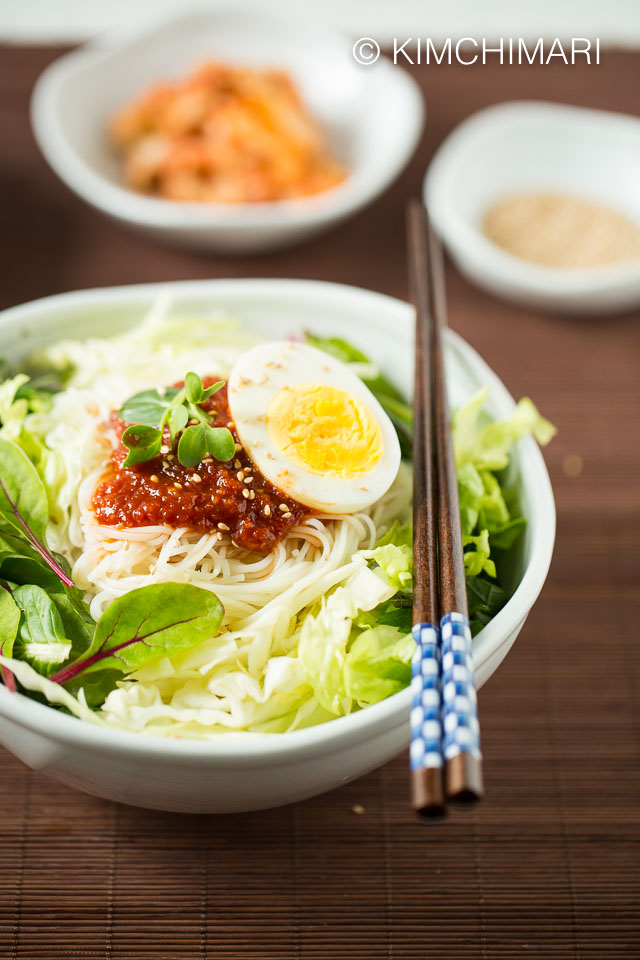
Bibim Guksu or Korean mixed noodles with spicy gochujang sauce was our family’s most favorite summertime weekend lunch menu when we lived in Florida many years ago. On weekend mornings, I remember sitting around with my husband trying to come up with lunch ideas and then every time I mention Bibim Guksu – he lights up and says YES!!!
When it’s so hot that you don’t even want to go outside and when any little bit of cooking just makes you too hot and sweaty (even with the AC going!), it’s really hard to find menu ideas that are appetizing but also easy to cook at the same time. But Bibim Guksu and Bibim Naengmyeon were always among our top choices. Just something about these COLD SPICY noodles!!😋😋
And because it was so easy to make, I just loved making it. The only thing about it was that I had to come up with something for my daughter to eat since she was just a toddler way back when. My usual solution was to make her what I LOVED eating when I was a kid. Cold noodles with sweet sesame soy sauce. Will share a quick recipe later.
So if you have kids or someone who cannot eat spicy, make this quick noodle dish with the same noodles. Just add some soy sauce, sugar, sesame oil and sesame seeds. So easy, you don’t even need a recipe but I bet your kids will love you for it.
Bibim Guksu History
Did you know that Bibim Guksu was not always spicy?? 😉Koreans started making spicy bibim noodles with gochujang only after the Korean war. Before the war, Bibim Noodles did not have gochujang in it and was seasoned with mainly soy sauce. And the toppings included things like pear, beef or pork, chestnuts and more. BTW, this non-spicy more classic version was called Goldongban 골동반 and its records go back all the way to the Chosun era.
What Noodles to use for Bibim Guksu
Bibim Guksu is usually made with either THIN (around 1 mm in diameter) white flour noodle called Somyeon 소면 or buckwheat noodles called Maemil Myeon 메밀면. Somyeon is further divided into machine made vs handmade. In my experience, there isn’t a HUGE difference between different somyeon but I found this one I bought to be quite good. It is ‘handmade’ noodles that have been made over 34 hr period in a 8-step process.
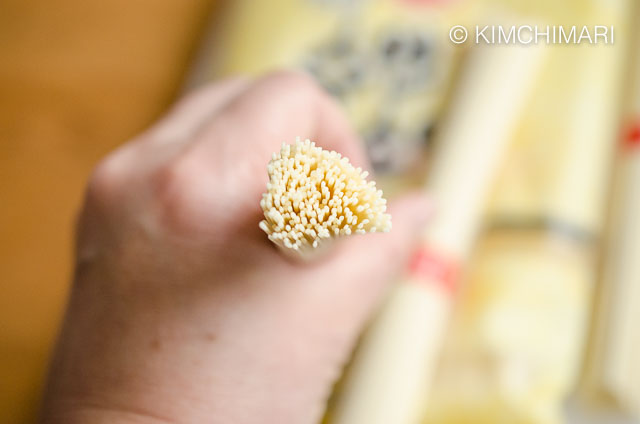
BTW, Guksu (국수) = Myeon (면 麵). Myeon is based on the Chinese character for noodles while Guksu is the pure Korean Hangeul word.
Rinse your Somyeon Noodles thoroughly
- Did you know that your Somyeon noodles have very high sodium level when it’s in the dry state? The package above has 1,770mg (89% DV) per 100g of dry noodles according to the package!! BUT once it’s cooked, it goes down to 178mg (9%) and then further down to 97.2mg (5%) after it is rinsed in cold water. The package does not say how many times it must be rinsed to reach 97 mg but since it says to rinse 3~4 times, I think it is best to follow that.
Chef’s Tips for Perfect Bibim Guksu
- Chewy Noodles – Don’t overcook the noodles. And put it in a cold water bath immediately. Rinsing noodles in cold water 3~4 times also help to make it more chewy, yummy and less salty.
- Make bibim sauce ahead of time – letting the sauce ‘mature’ in the fridge for 2-3 hrs will make the sauce taste extra yummy. Sauce will keep in the fridge for few days so make a large amount and use it later.
- Add Kimchi topping for extra flavor – classic Goldongban always had a kimchi topping. Just chop up some kimchi and season it lightly with some sugar and sesame oil.
- Add crunchy vegetable like green cabbage to add texture. But if you don’t have that, thinly slice other crunchy veggies like Brussel Sprouts or something similar.
- Add flavorful herbs like Perilla or Ssukat for extra flavor. Cucumbers are also a great addition, esp. in the summer.
- SERVING – enjoy it with a side of homemade pickled radish (recipe below) or Danmuji (Japanese style pickled yellow radish). Also make some mild soup like Odeng Soup to help you wash down the noodles.
- EASY vegetable idea – use some spring salad mix + cole slaw cabbage mix instead of cutting up all the vegetables.
- GLUTEN FREE option – use 100% buckwheat noodles or any other gluten-free noodles that works well when it’s cold. Also remember to use GF soy sauce like Tamari and make sure you have Gochujang that does NOT contain wheat or barley (sometimes they do, mostly they don’t but).
Step-by-Step Directions
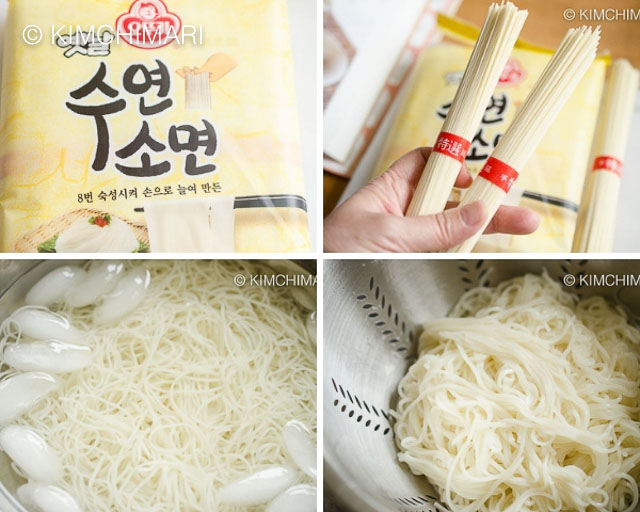
- Boil a pot of water to cook noodles in. Follow directions on the package. I boiled my noodles in 5 cups of water (for 100g of noodles) for 2-3 minutes. Then rinse 3~4 times in cold or even ice water. Drain. Rinsing in cold water prevents the noodles from sticking, makes them chewy and less salty.
- Cook hard boiled eggs. Peel and cut into 1/2. 1/2 egg will be used for each bowl.
- Clean and peel onion, garlic and apples.
- Cut onion an apples into smaller chunks to fit into your blender or chopper.
- Chop or blend until smooth.
How to make Bibim Sauce for Bibim Guksu - To the chopped or grated onion+apple+garlic mix from 3, add vinegar, soy sauces, gochujang, sugar, honey, gochukaru (Korean red chili powder) and sesame oil. Mix and set aside or keep in fridge for later.
Bibim Guksu Sauce all mixed and ready to use - For the vegetable topping, rinse the following: cabbage, spring mix and/or red leaf lettuce. Optionally, rinse perilla leaves (kkaetnip 깻잎) and chrysanthemum leaves (ssukat 쑥갓) for extra flavor.
- Cut lettuce and perilla into thin strips.
- Julienne cabbage.
Cut Veggies for Bibim Guksu - When it’s time to serve, assemble a bowl with noodles then arrange cut vegetables on top. Add egg on top.
Bibim Guksu in Bowl with vegetables - Pour bibim sauce – probably about 2 Tbs for one large bowl (per serving). Garnish with some daikon sprouts (optional) and sprinkle sesame seeds and a swirl of sesame oil.
SERVING SUGGESTION: serve with some extra sesame oil, sesame seeds, some seasoned kimchi, pickled radish or Danmuji – like below – OH and also some extra BIBIM SAUCE!!

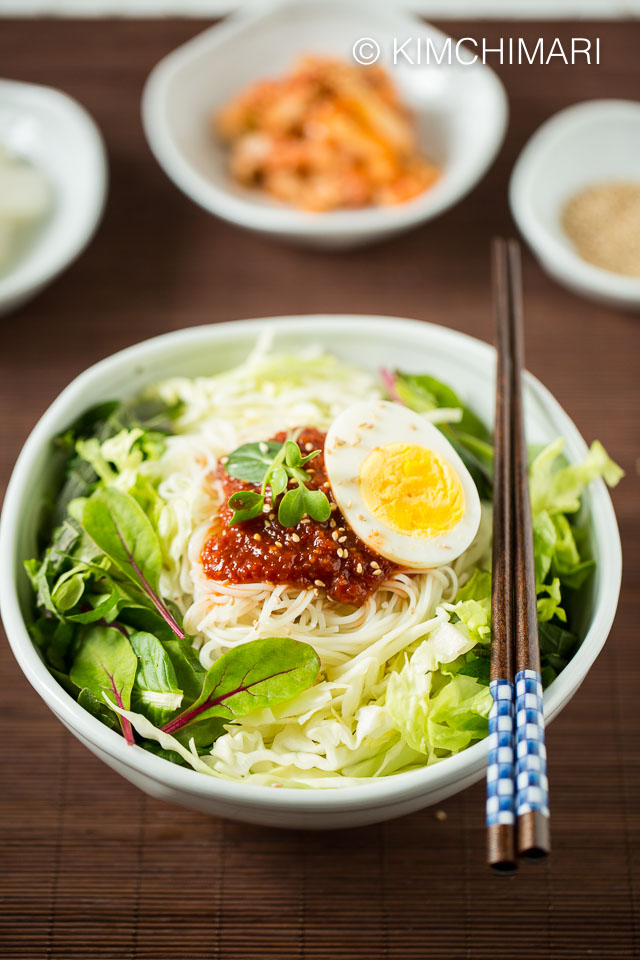
Here’s a close up when it’s all mixed!! It’s sooo good. You will not regret it if you make this. 😍😋
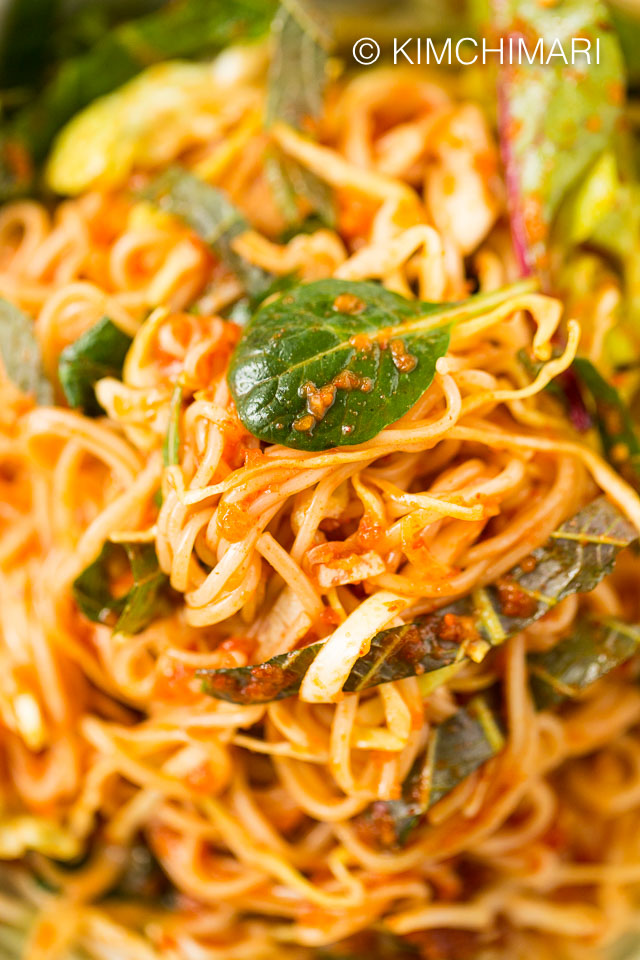
BONUS – COLD NOODLES for KIDS!! – with Sweet Sesame Soy Sauce
- With the same cold Somyeon noodles, just mix it with some soy sauce (Jin Ganjang), sugar, sesame oil and sesame seeds. Make it sweet and your kids will LOVE IT!! ❤️
If you like Bibim dishes, try my Dolsot Bibimbap Recipe with crusty BURNT rice and using easy-to-buy ingredients.
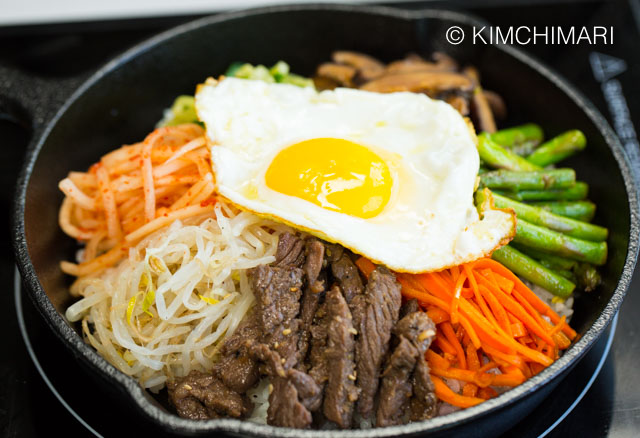
And if you want to try another cold summer noodle dish, here’s my Soba Noodle Salad which was an immediate HIT as soon as I shared it!
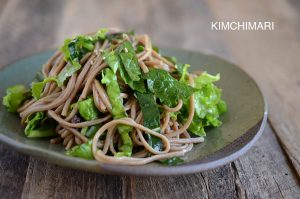
If you have tried this Bibim Guksu or any other recipe on my blog then please don’t forget to rate the recipe (top right of the recipe card) and leave me a comment to let me know how you like it! Every 5 star helps me a lot and I also love to hear from you! 😍
You can also FOLLOW ME on FACEBOOK, PINTEREST and INSTAGRAM or join my FACEBOOK GROUP to see other Korean recipes to ask and share everything about Korean food with others just like you!
Enjoy~ ❤
JinJoo
Bibim Guksu (Korean Spicy Cold Noodles with Gochujang Sauce)
Ingredients
- 100 g Somyeon Guksu (thin dry Korean noodles)
- 1 each egg (hard boiled)
- 5 cups water (to cook noodles in)
Bibim Sauce
- 1 oz fuji apple (can use other kind of apple) (1 oz apple = 1/4 of an apple (see pic) = 2 Tbsp grated)
- 0.5 oz onion (0.5 oz = 1 Tbsp grated onion)
- 1 clove garlic
- 1 Tbsp rice vinegar
- 1 Tbsp Gochujang (Korean red chili paste)
- 4 tsp Gochukaru (Korean red chili powder)
- 2 tsp soy sauce (Jin Ganjang)
- 1 Tbsp sugar
- 1 Tbsp honey
- 1 tsp sesame oil (more to taste)
- 1 tsp Guk Ganjang (Soy Sauce for Soups)
Vegetables
- 3 each red leaf lettuce leaves
- 3 each perilla leaves
- 1 cup cabbage (sliced thin)
- 1/2 cup Spring Mix
- 1/2 cup cucumber (Korean/English/Persian/Japanese) (julienned)
- 1 daikon sprouts
Pickled Daikon Radish - OPTIONAL
- 4 oz Korean radish or Daikon (sliced 1 inch wide)
- 1/2 tsp Korean sea salt
- 1 tbsp rice vinegar
- 1 tbsp sugar
Kimchi Topping - OPTIONAL
- 1/4 cup cabbage kimchi (sliced)
- 1/2 tsp sesame oil
- 1/4 tsp sugar
Instructions
Noodles and Eggs
- Boil a pot of water to cook noodles in. Follow directions on the package. I bought this bag and this one said to boil 5 cups of water (for 100g of noodles) and cook noodles for 2-3 minutes. Then rinse 3~4 times in cold water. Drain. Note, rinsing in cold water prevents the noodles from sticking too much and also makes them chewy.
- Cook hard boiled eggs. Peel and cut into 1/2. 1/2 egg will be used for each bowl.
Bibim Sauce
- Clean and peel onion, garlic and apples. Cut onion an apples into smaller chunks to fit into your blender or chopper.
- Chop or blend until smooth. If you don't have a chopper, just grate all of them.
- To the chopped or grated onion+apple+garlic mix from 3, add vinegar, soy sauces, gochujang, sugar, honey, gochukaru (Korean red chili powder) and sesame oil. Mix and set aside or keep in fridge for later.
Vegetable Toppings
- Rinse the following: cabbage, spring mix and/or red leaf lettuce. Optionally, rinse perilla leaves (kkaetnip 깻잎) and chrysanthemum leaves (ssukat 쑥갓) for extra flavor.
- Julienne cabbage (finely). Cut lettuce and perilla into thin strips. Break chrysanthemum leaves into smaller pieces by hand.
- Assemble a bowl with noodles then arrange cut vegetables on top. Add bibim sauce and 1/2 an egg on top. Finish with some daikon sprouts (optional), sesame seeds and a swirl of sesame oil. OR serve sesame oil and sesame seeds at the table.
Pickled Radish
- Optionally, slice radish into 1 inch wide thin slices and sprinkle salt and let it sit for 10 minutes. Then add sugar and vinegar and mix. Serve as a side dish or with the noodles.
Tips & Notes:
- Chewy Noodles - Don't overcook the noodles. Rinsing noodles in cold water 2-3 times also helps to get rid of sodium and makes it more chewy.
- Let bibim sauce Mature - letting the sauce 'mature' in the fridge for 2-3 hrs will make the sauce taste extra yummy. Sauce will keep in the fridge for few days so make a large amount and use it later.
- Add Kimchi topping for extra flavor - classic Goldongban always had a kimchi topping. Just chop up some kimchi and season it lightly with some sugar and sesame oil.
- Add crunchy vegetable like green cabbage to add texture. But if you don't have that, thinly slice other crunchy veggies like Brussel Sprouts or something similar.
- Add flavorful herbs like Perilla or Ssukat for extra flavor. Cucumbers are also a great addition, esp. in the summer.
- SERVING - enjoy it with a side of homemade pickled radish (recipe included) or Danmuji (Japanese style pickled yellow radish). Also make some mild soup like Odeng Soup to help you wash down the noodles.
- EASY vegetable idea - if you don't have the time or the ingredients, just use some spring salad mix and cole slaw cabbage mix - no need to cut all the veggies.
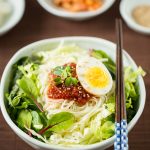
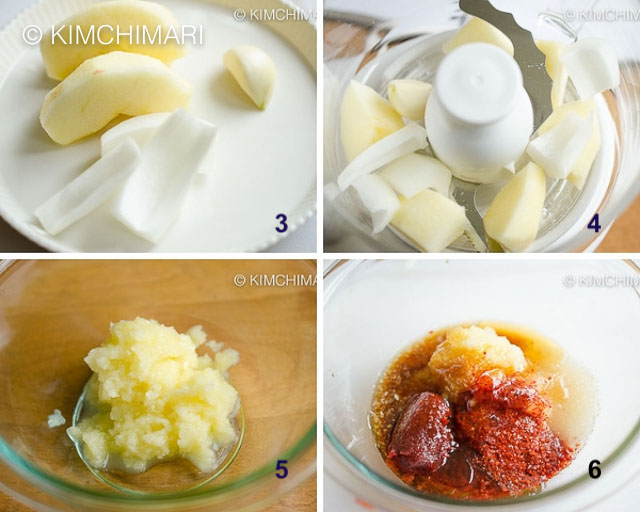
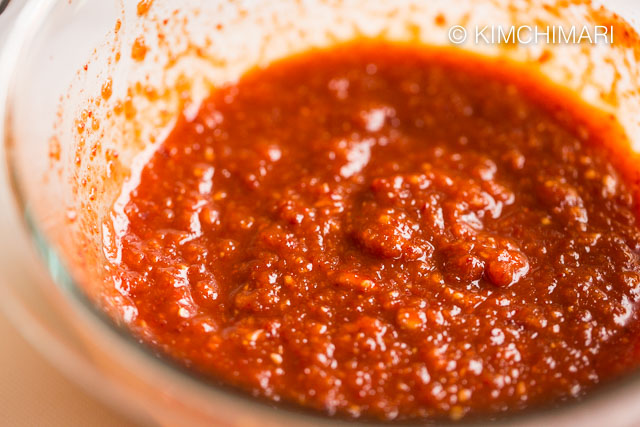
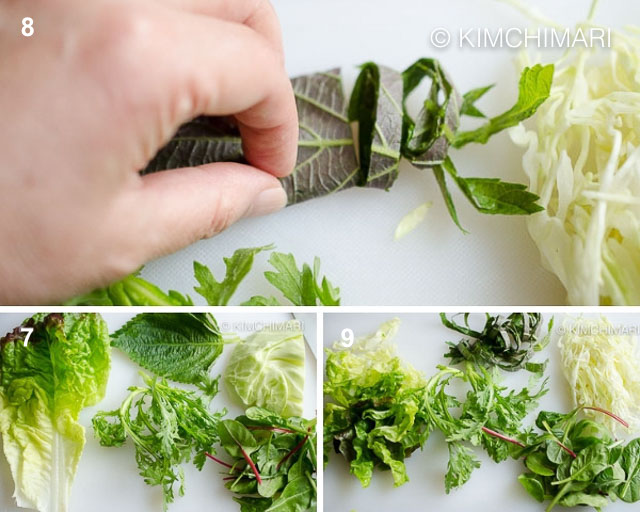
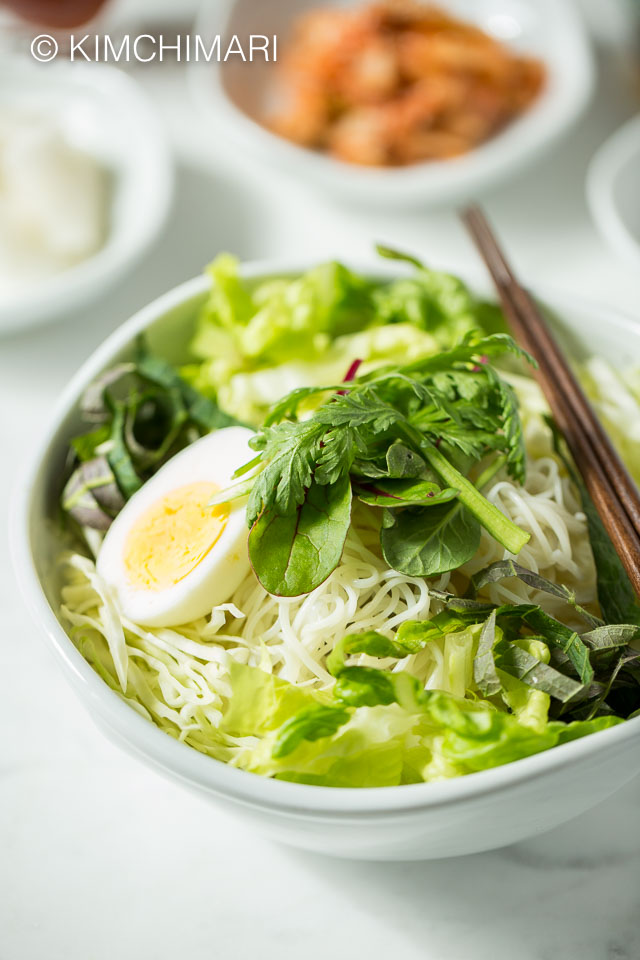

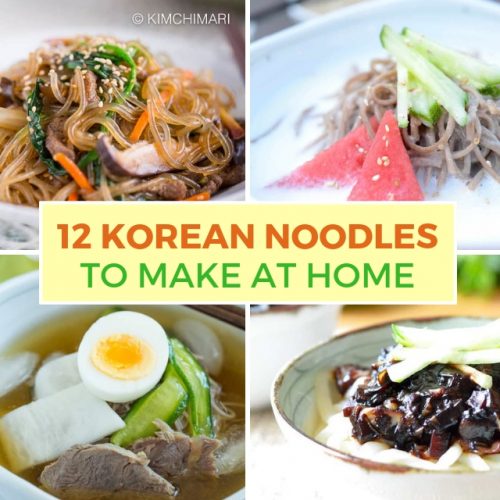

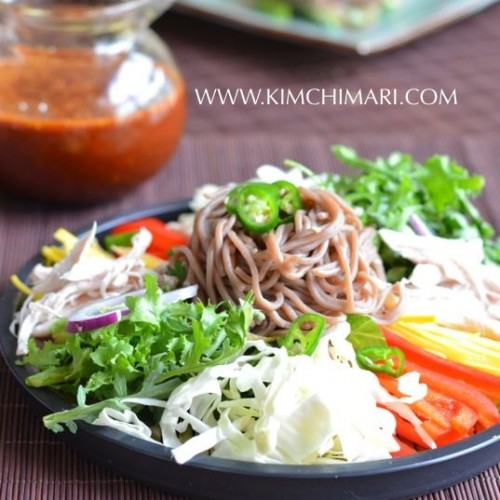
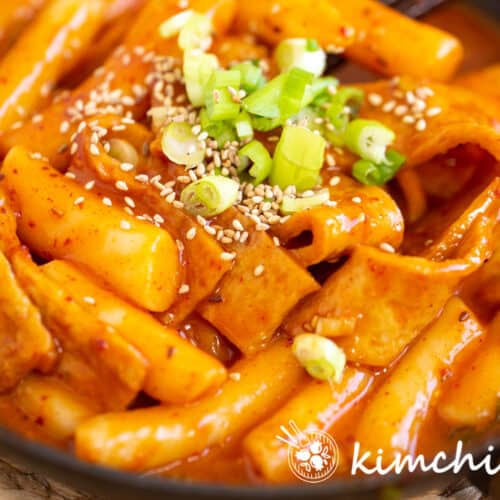
















I was looking for a quick dinner with Korean flavours and this recipe is fantastic! I served it with some thinly sliced pork belly, delish
Ooh Bibim Guksu and pork belly sounds amazing!! So happy that you enjoyed it. Thank you for sharing!